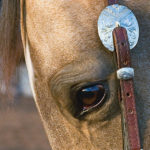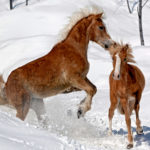Enjoy this short video from the FEI headquarters in Europe. It’s in English, and explains a good deal about the planes used to transport the European horses to Cincinnati for their quarantine before they are allowed into the Kentucky Horse Park. You?ll meet Henry Bullen of Peden Bloodstock in Germany; Peden Bloodstock is the longtime flight contractor with the FEI for international competitions.
Peden will oversee the transport of almost 450 horses from Europe between last Thursday and the 29th of September. The airlift of horses is the largest ever undertaken for one event. Ten specially fitted out charter flights were contracted from Belgium?s Liege airport and one flight will depart from Amsterdam. Another 19 will fly from Australasia and 35 from South America.
According to a press release from the Alltech FEI World Equestrian Games media department, during the nine-hour journey from Europe, the horses will be cared for by an in-flight crew of 24, including grooms, attendants and vets, many of them professional flying grooms who make their living tending to the needs of their equine passengers.
Head Groom Tim Rolfe of Peden Bloodstock, who has overseen six Olympic and five World Equestrian Games airlifts, explained that the grooms must spend many months in training to undertake such journeys.
?Most of us come from racing or grooming backgrounds but we have to undertake similar training to commercial airline cabin crew, particularly as we have to look after the human passengers as well.?
The class of cabin is determined by the number of horses in each ?air stable?. Those travelling economy will be three to a container, two horses will share business class containers and those in first class have the air stable all to themselves. Most opted for business class. Only one horse will get that luxury on the flight from Belgium, but the high-flyer?s identity is staying firmly under wraps.
Ticket prices range from ???8,500 to ???13,000 depending on the class selected, but considering most of these horses are worth several million Euro, it’s money well spent.
The horses? safety and welfare are paramount, with the pilots specially briefed to ensure that the take-off and landings are smoother than usual. The take-off will involve a more gradual climb, whilst a much slower braking system is adopted for the landing.
The horses have a constant supply of in-flight food. They can snack ad lib on their hay nets and will also be offered a diet of nuts, oats and bran. Over 1,500 litres of water will be taken on board to ensure the equine passengers are kept well hydrated whilst in the air.
In-flight entertainment is taken care of by the flying grooms, according to Peden Bloodstock Director, Henry Bullen, who said, ?It is too loud on board to warrant anything like soft music, but there are plenty of bad jokes from the flying grooms to keep everyone entertained. The flight, once in the air, is generally smoother than on the road however, unless of course there is the odd patch of turbulence.?
Once the horses arrive in Cincinnati, the horses will spend up to 42 hours in a purpose-built quarantine facility near the airport, before departing on the 90-minute road-trip to the Kentucky Horse Park, venue for the 2010 Alltech FEI World Equestrian Games???.
Thanks to WEG and the FEI for assistance with this blog post.





